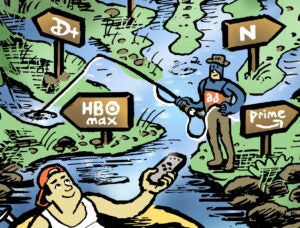 “On TV And Video” is a column exploring opportunities and challenges in programmatic TV and video.
“On TV And Video” is a column exploring opportunities and challenges in programmatic TV and video.
Today’s column is written by Bryan Noguchi, senior vice president and media director at R2C Group.
I recently formed a small roundtable discussion on programmatic TV buying, drawn from approximately 100 sales executives, representing more than 40 cable and broadcast networks.
There was a lot of interest in participating until I mentioned that I might write about it. After that, cue the crickets. So I promised I would not cite any network specifically or quote anyone directly and was able to build a quorum.
My experience in simply putting this discussion together is telling: Despite what you might hear or read, there’s not much appetite for owning any position on this topic at the moment. As I informally canvassed the larger sample, and not just my panelists, I found that there seems to be basically three camps.
The first camp believes programmatic will change the world and we are in the vanguard. The second camp sees programmatic as mostly hype that has yet to prove itself on even the most basic level. And those in the third camp believe programmatic is a hot topic, but please don’t tell anyone they don’t know anything about it.
Fear And Loathing
I get it. Nobody wants to look stupid – or worse, like some kind of Luddite.
My own teams, as they evaluate partners in this space, are often hesitant to make technology pronouncements. “There doesn’t seem to be any there there” is a hard thing to say when you’re in uncharted territory.
That’s not to say that all or even most of the current offerings are vaporware. Quite the contrary – we’ve seen some really promising technologies. The networks are clearly wetting their toes to varying degrees. Some networks are well along in developing and deploying proprietary solutions. Others have clearly been experimenting with different buckets of inventory using third-party technologies.
One thing that a lot of us have seen: Many of the third-party solutions out there tend to either represent pretty exciting technology that isn’t coupled with very good inventory, or they’ve accessed great inventory with not much of a technology stack on top of it.
At least on the network side, my sense is that most are on the sidelines, waiting to see how all of this shakes out.
The Primary Hurdle
One thing that is clear to me is that the primary hurdle is actually quite basic and must be addressed before we can start talking about the sexy stuff, such as advanced targeting, real-time bidding, supply-side platforms and private exchanges.
I don’t know whether this is surprising to anyone or not, but the management of inventory is far from uniform and varies from network to network, with pretty significant differences in sophistication. If we talk about programmatic at the most basic level – the use of technology to connect buyers and sellers in a uniform, automated environment – this is an important issue because “programmatic” can’t exist if inventory is managed in Excel, any more than it could be if it were locked away in a hyperproprietary mainframe environment.
That seems to be the spread of current management solutions on the network side. The implication is that any programmatic technology that gets overlaid onto a given network’s inventory is practically a custom implementation every time. Until the day that inventory is based in a common exchange, what in theory should be a single, simple pipe actually needs to be a couple hundred pipes, each with unique diameters and bends. And that’s just the sell side.
Where many smaller agencies might welcome a cloud-based dashboard interface, most of the larger shops will run proprietary systems that will require their own API implementations as well.
So this begs the questions that will plague the early days of programmatic TV: Who’s connected to whom? And will there be enough scale in the nascent ecosystem to justify the investment in IT resources to implement the technologies?
It’s a very chicken-and-egg situation where networks want to ensure that enough agencies are in play, and agencies want to see how many networks are in the game. At the moment, I’d say many of us are doing enough to appear proactive, but beyond that, it feels like a lot of hedging.
What Constitutes ‘Inevitable’?
I have a lot of digital media in my background, so for me the notion of programmatic TV buying, despite the technical hurdles, is a foregone conclusion. It’s not an “if” but “when.”
What surprised me were the number of voices who were – off the record – prepared to question whether this is inevitable at all. In addition to the issues I’ve cited above, there were some voices who were pretty vigorous in questioning whether the promise of bottom-line revenue benefit could even really materialize, noting anecdotally that the value derived from experimental buckets of inventory had actually been suppressed relative to the prices they could have commanded within the structure of the current media marketplace.
I have no doubt that the market will sort through the kinks – such is my faith in technology – but it does give me pause. Where I once would have put a five-year timeline on the transition, I think it may be substantially longer than we think. That “inevitable” may be a hard-earned slog vs. an overnight revolution.
And to be honest, from a utility and usability standpoint, our programmatic TV future will be better for having earned its place.
Follow R2C Group (@r2cgroup) and AdExchanger (@adexchanger) on Twitter.













